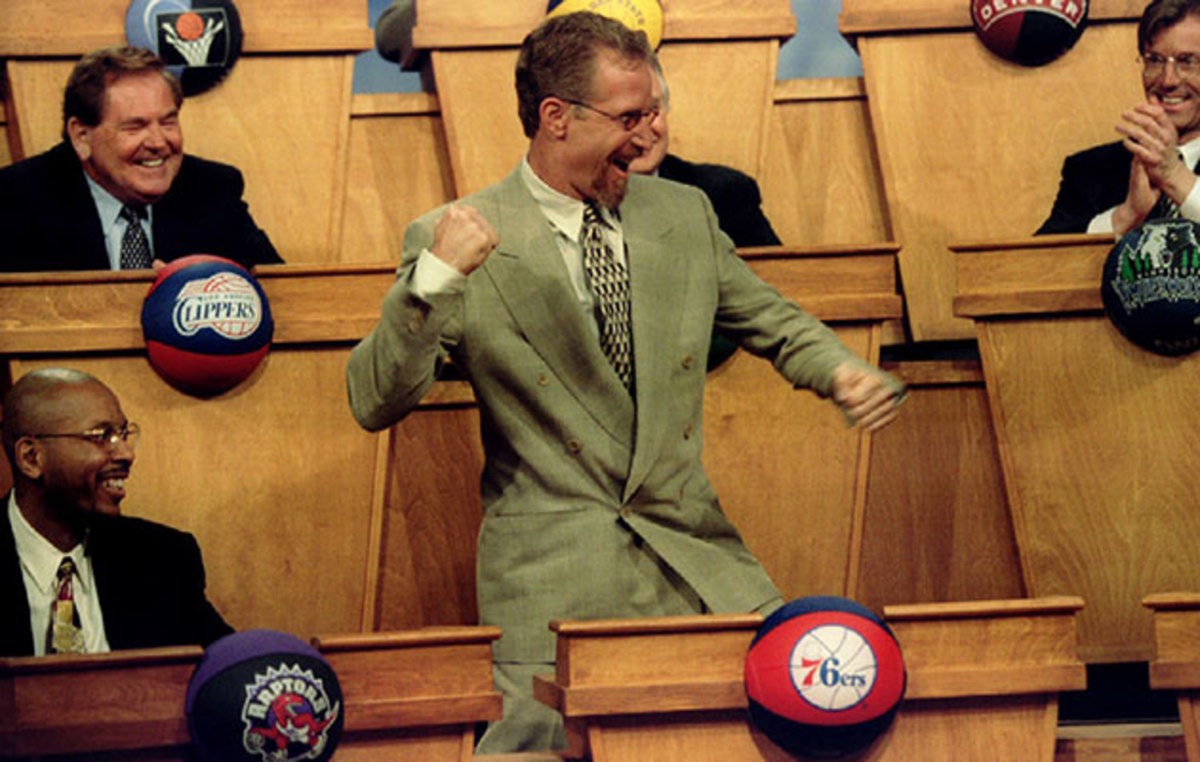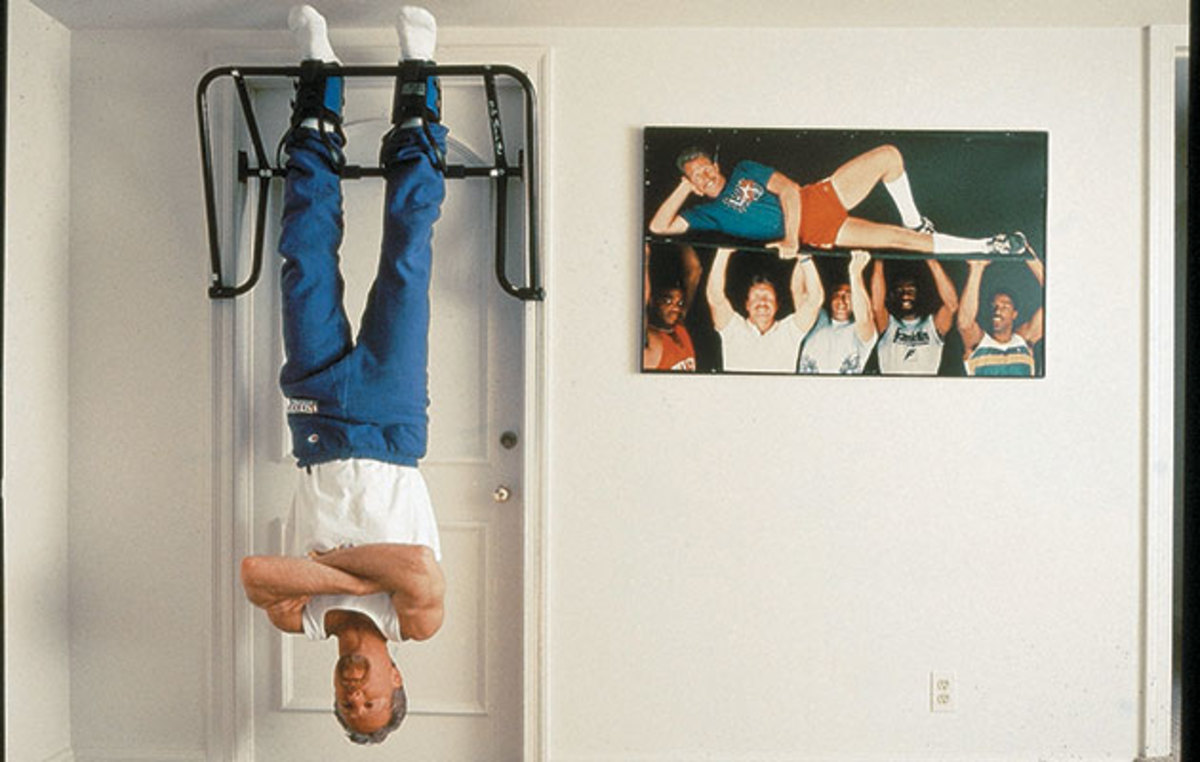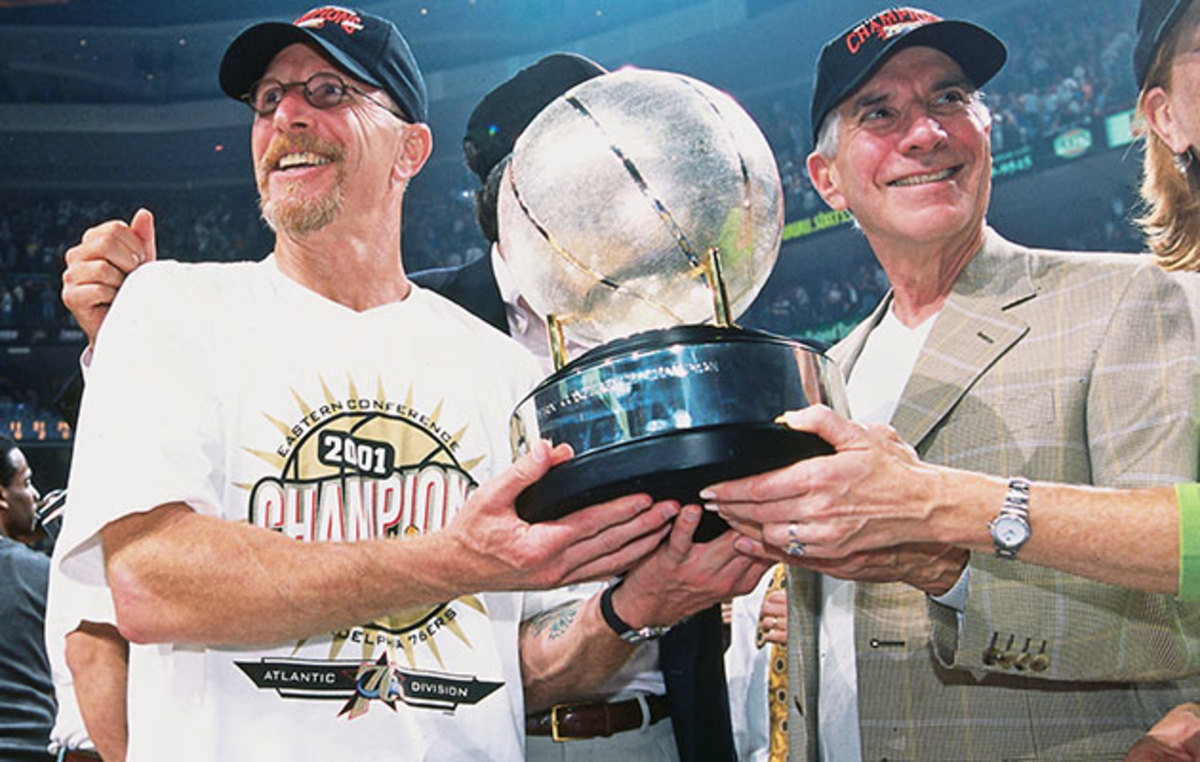Pat Croce, ex-Sixers owner and part-time pirate, at peace with retired life

Pat Croce is sitting still. Finally. Of course, there’s not much room to move around in a five-seat, twin-propeller plane zipping at 150 mph into a headwind as it leaves Key West for St. Augustine.
The former 76ers owner and president sits with both feet flat on the floor and his head three inches from the ceiling. His rolled-up sleeves reveal tattoos on his forearms. On his left wrist, the typical spot for a watch, he has the Chinese characters for now. In Croce’s world, that is perpetually the time: now.
He pops in his headphones and opens a meditation app on his phone with ambient sounds and chiming bells. As the plane leaves the earth, Croce mentally does the same.
“See you in 25 minutes,” he says cheerfully, and then closes his eyes.

It’s hard to believe Croce practices daily meditation. Twenty years ago his national fame grew precisely from his inability to keep still.
At the 1996 NBA draft lottery, Croce represented the Sixers on the dais. The league had asked the 13 proxies to stay seated and show decorum. When he won the No. 1 pick—the rights to Allen Iverson—Croce instead leaped around the stage high-fiving the losers. That contagious enthusiasm was the hallmark of his five-year tenure running the team.
Many fans remember him climbing Philadelphia’s Walt Whitman Bridge to hang a banner before the 2001 Finals. But few know he’d planned an encore: Had his team won a second game against Shaq, Kobe and the Lakers to force Game 6 in Los Angeles, Croce says he would have rappelled from a helicopter to drape a 76ers banner over the H in the HOLLYWOOD sign. He’d already reserved the chopper.
“There was no permission!” he says. “They could have arrested me. Philly would have loved that.”
The laws of California airspace would not be the first rules Croce had ever tried to finesse. He’s fancied himself a swashbuckling pirate ever since the days when he carved Pat the Great, along with a skull and cross bones, into a grade school ruler.
• SI’s Where Are They Now issue: This year’s stories, all in one place
There are other places Croce likes to sit, cheaper than a $3,000 chartered plane. Take, for instance, the chipped and weathered grey bench at the corner of Southard and Whitehead, at the southern tip of Route 1 in Key West, Fla. “The boardroom,” Croce calls it, where he can, “sit and watch the universe go by.”
Croce’s first trip to Key West, in the early 1990s, was unplanned—the result of bad weather, a canceled family skiing vacation and a spontaneous thought: Let’s see if we can find Jimmy Buffett. Now he and Buffett are friends.
“That’s how the universe unfolds,” Croce says.
He kept coming back. After resigning from the Sixers in 2001, he also began collecting properties as if playing a 15‑year game of Monopoly, acquiring six Key West bars and restaurants.
“You’re building an empire,” says Tony from South Philly, the latest friendly stranger to approach him at the bench. (He doesn’t know every soul in Key West, it just feels like it. “He was that way in high school,” says Diane, his wife of 38 years. “He was like the mayor. Everyone knew him and wanted to say hi.”)
If you want a tour of his empire, Croce can show you around by bicycle—his is red with silver skulls on the ends of the handlebars. There’s the Green Parrot, which has been ranked by Playboy as one of the top bars in America. And Turtle Kraals, right on the water, where even Dale Earnhardt Jr. has participated in the famed turtle races. Then there’s the Rum Barrel, where painted pipes in the ceiling display the distance from exotic locales like Cuba, Barbados and . . . Philadelphia. Welcome to the southernmost Philly sports bar in the nation. When the Phillies won the 2008 World Series, Croce organized a parade; several hundred fans marched from the Rum Barrel to the local cheesesteak joint, accompanied by a rumba band and a police escort.
“Is that the Pat Croce?”
The scream comes from across the restaurant and suddenly Croce is mobbed like Rocky running through the Italian Market. One by one guests take pictures. Croce not only poses but makes sure each shot has proper lighting and background.
“And this is the off-season,” he says.
But the unofficial mayor of Key West will soon be leaving his people.
• From the Vault (1996): Hard-driving Pat Croce fired up about the No. 1 pick
Croce retired from his position as chairman of Pat Croce & Company in November 2014, shortly after turning 60. He’s still the majority owner of all his properties, but his son Michael and son-in-law Jeff handle the day-to-day responsibilities. Though Pat has done well in the restaurant business, it doesn’t take long for his true passion to come up: pirates.
In 2004, Croce turned his lifelong fascination and extensive collection of artifacts into a pirate museum in Key West, which he dubbed Pirate Soul and housed in a building he purchased for $3 million. Around that time, he dove the wreckage of Blackbeard’s ship, Queen Anne’s Revenge, off the Carolina coast, finding pewter silverware and a plate with a bullet hole. His most ambitious voyage was two weeks in 2011 spent looking for Sir Francis Drake’s remains off the northern coast of Panama. Drake, whom Croce calls the greatest pirate ever, is buried at sea. Croce knows what the ships and coffin look like—he owns Drake’s captain’s logs.
“I didn’t care about treasure,” he said. “I wanted a pirate. I was gonna bring his body back to Queen Elizabeth. You’d be calling me Sir Pat Croce.”
Croce’s team discovered two sunken ships. It’s not 100% confirmed, but he’s confident he found Drake’s scuttled boats—though no skeletons.
Lately he’s been on a different kind of voyage.
John Vagnoni is a partner and general manager of the Green Parrot. In his words, he got off a bus at that corner in 1973, it was 15 cent beer night and he never left.
Vagnoni opened a mini library in a bookcase on the bar’s porch, visible from Croce’s bench. Eighteen months ago a woman donated “The Art of Happiness” by the Dalai Lama. Croce picked it up and was hooked. The book began a spiritual awakening. After 60 years chasing aggressive goals, Croce is now taking time to be mindful.
“It’s been quite dramatic,” Diane said. “When he sets his mind to something, he doesn’t stick his toe in the water. He just jumps in. When he turned that focus inward, it was with the same intensity.”
“She thinks she died and hit the jackpot,” Croce says of his wife’s reaction to his newfound temperament. Friends say he’s more at ease, with a longer fuse. He has also donated $250,000 to the Center for Contemplative Studies at his alma mater West Chester (Pa.) University to spread the word about mindfulness and meditation.
“It allows me to drop a pebble in a bigger pond,” Croce said.
He now starts his day at 4:30 a.m. by journaling and studying Chinese. Whenever he reads, he jots down memorable passages and later translates his favorite sayings from English to Chinese. This morning’s best proverb is from Albert Einstein: “I never think of the future. It comes soon enough.” That’s quite a turnaround for a man who said, in a 1996 SI profile, “The future is so exciting that I can’t wait to get there.”
Though he seems to have found a new calm, reminders of his old pace do remain, particularly in the gym. “For me that’s like going to church,” Croce says. “That’s one thing that hasn’t changed in 20 years.” The gym was his entrée into the world of pro sports. He took on jobs, first with the Flyers, then with the Sixers, and his company Sports Physical Therapists grew to 40 locations before he sold it. Some of the top athletes in Philadelphia history—Dr. J, Bobby Clarke, Charles Barkley back in his svelter days—belonged to Croce’s private fitness club. Croce says that in Mike Schmidt’s Baseball Hall of Fame speech, “He thanked God, his wife and me.”
Croce now weighs 160 pounds, down from 168 during his competitive karate days, and he’s still remarkably fit. Michael, the father of five of Pat and Diane’s eight grandchildren, says Pop-Pop is “the only one with enough energy to tire them out.”

As much as the Croces love Key West, the pirate museum never flourished there. In 2010, Croce moved it to St. Augustine, which is why the charter plane is zipping across Florida at 9,500 feet, low enough to pick out Disney’s Epcot ball without a zoom lens.
Croce says the U.S.’s oldest permanent settlement offers a better location, and not just because of the many schools in need of field trips. The St. Augustine Pirate & Treasure Museum now sits just 500 feet from the Castillo de San Marcos, the oldest masonry fort in North America, which has stood since the 1600s, surviving even Drake himself. And on the second-floor balcony of the apartment connected to the museum, Croce has found himself another great seat.
“It’s the best front porch view in St. Augustine,” says Dana Ste. Claire, director of the city’s heritage and tourism department, who helped Croce design the museum. Croce, who spent his whole life fascinated by pirates, now sits holding a Partagás Cuban cigar and a glass of Zacapa XO rum, looking out at a bay where actual pirates once came to burn and pillage the town.
“Imagine all that happened in that bay,” Ste. Claire says. “Pirate attacks, British cannon fire. And it was never taken. It kind of captures Pat’s spirit.”
The museum next door is full of original artifacts—Captain Kidd’s family bible; one of only three authentic Jolly Roger flags still in existence; and Thomas Tew’s chest, the only actual pirate treasure chest in the world. Croce also proudly displays a chunk of wood he brought back from what he believes are Drake’s ships.
“This isn’t Pirates of the Caribbean,” he says. “This is the real f------’ deal.” (Though Croce does have Captain Jack Sparrow’s actual sword from the movie in the Pirates of Hollywood exhibit.)
In 2013, on land next to the museum, Croce opened Colonial Quarters, a park with a walking tour that teaches three centuries of St. Augustine history. He owns a couple of nearby restaurants and bars, also run by Michael and Jeff, who oversee the museum as well.
The purpose for this trip from his main home in Villanova, Pa., down to his properties in Florida was actually to pack boxes and say goodbye to the house in Key West, with its L-shaped pool and mango trees in the backyard. It is no longer part of the Croce empire, now that he doesn’t need to be in Florida as often.
“It was a wonderful home, but now it’s a past memory,” Croce said. “Not much different than the dream you had last night.”
Croce bought 41 acres in Bucks County, Pa., a “place to disappear.” He took a chain saw to the backyard to clear out a hiking path before he even officially owned the property. There will be hills to go sledding with the grandkids, and there’s talk of a moonshine operation.

The Pat Croce who left the 76ers in 2001 was very different from the one who now focuses so much of his life on mindfulness and contemplation.
“My ego got in the way,” he admits of his divorce from the team. No longer content merely running the Sixers, Croce wanted control of all of Comcast Spectacor, which included the Flyers, two arenas and a television network.
“I believed I could do more,” he says, “even though in the beginning people thought a physical therapist couldn’t run a basketball team.” A power struggle played out in the press between Croce and Flyers chairman Ed Snider, which ended with Croce’s resignation. Croce says he never wanted to take Snider's position, but their relationship was never the same.
“I was hurt,” Croce said. “He was like an entrepreneurial father figure to me.”
But when Croce heard Snider was sick this spring, he reached out to Ed’s son Jay with both apology and forgiveness. He and the Sniders traded warm messages, and Croce attended Ed’s memorial ceremony in April.
“I really did love the man,” Croce said. “He opened doors for me.”
Croce hasn’t been back to many Sixers games, but he attended Iverson’s jersey retirement in 2014 and plans to be in Springfield for his Hall of Fame induction in September. When Croce texted Iverson to congratulate him on the honor, A.I. responded that he couldn’t have done it without him and used six exclamation points.
Though Croce tries not to look either forward or backward, he’ll always be part of that 76ers era. It’s been 20 years since he completed his unprecedented rise from the training room to the owner’s box, and 15 since his hometown team stood on the doorstep of the ultimate prize.
And now Pat Croce, the meditative pirate, is finally sitting still. For at least 25 minutes a day, sometimes at 150 miles per hour.
